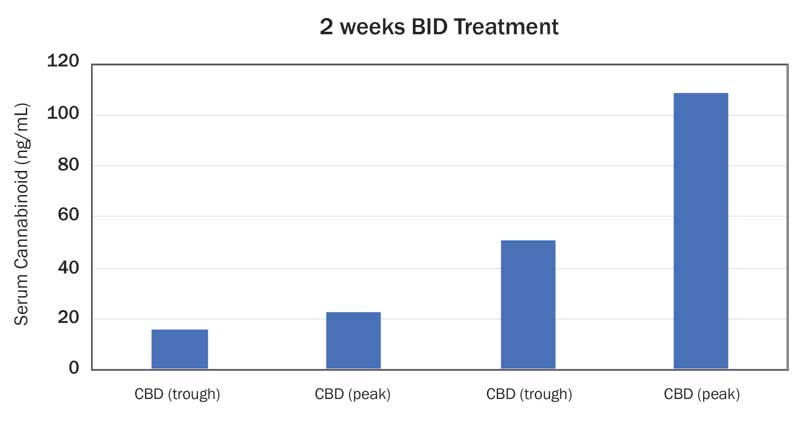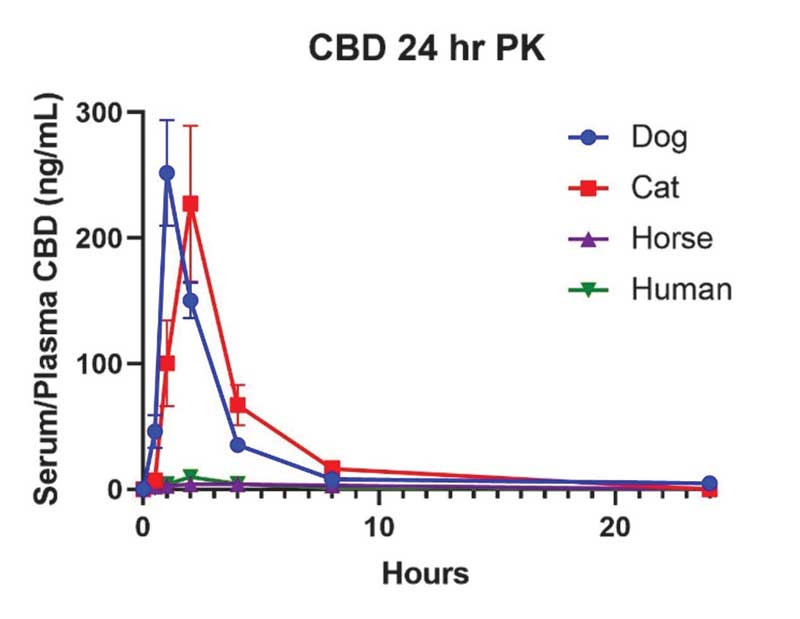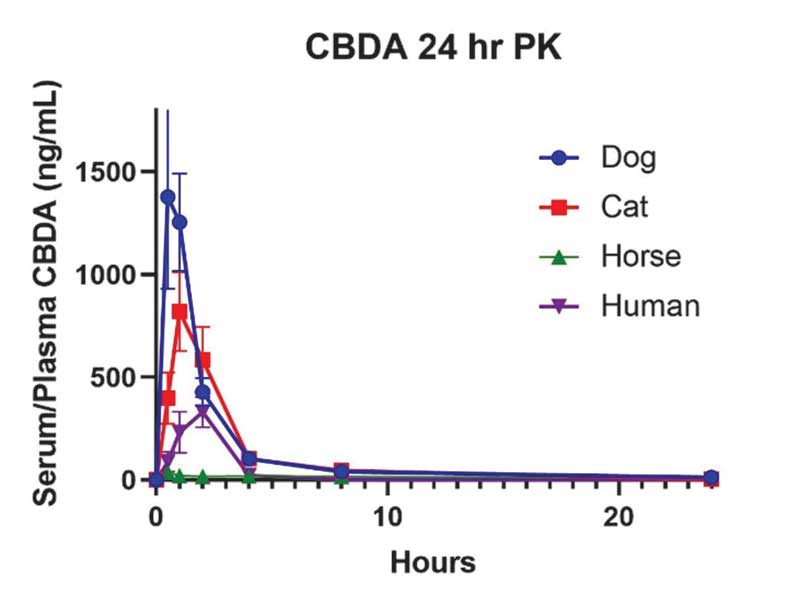It is safe to say the use of cannabinoids, in particular cannabidiol (CBD) and its acid derivative (cannabidiolic acid or CBDA) in veterinary medicine is growing, with indications across osteoarthritis pain, atopic dermatitis, and refractory seizures in dogs.1-4 What is less clear is the treatment across veterinary species, and the first necessary investigations into the use of CBD and/or CBDA is to assess the pharmacokinetics in the species
of intent.
It is becoming evident the pharmacokinetics of CBD and CBDA across species appears to be variable, suggesting differences in dosing recommendations. This article outlines the studies performed in dogs, cats, horses, and a few pocket pets/exotics to date, and provides evidence for differing dosing across species.
The important parameters addressed are maximal concentration (CMax), and half-life (T ½). In some studies, the pharmacokinetic steady state has been examined to determine if the serum concentrations back up the use based on concentrations known to affect the receptor systems involved in the endocannabinoidome.5
The endocannabinoidome
The receptor system typically known as the endocannabinoid system revolves around the cannabinoid receptor 1 and 2 activity, which are the primary receptors Cannabis sativa, rich in delta 9-tetrahydrocannabinol (THC), stimulate to induce psychotropic activity.6
As we are discussing CBD and CBDA from hemp (Cannabis sativa with less than 0.3 percent THC), it is known these two cannabinoids are not agonists of these receptors, but are actually inverse agonists or possible antagonists of this receptor system.6,7 The main question that lingers is: What receptors do CBD and CBDA act at?
CBD and CBDA actions involve other receptor systems which have led to the expansion of receptor systems known as the “endocannabinoidome.” These receptor systems primarily influence neuronal action potential and neurotransmitter release, including the transient receptor potential cation channels subfamily villanoid receptors (V receptors), glycine receptors, calcium channels, 5 hydroxytryptophan (serotonin), and g protein orphan receptors as either agonists or antagonists.6,7
CBD and CBDA are also agonists to the peroxisomal proliferation activation receptors, which are nuclear receptors involved in regulation of the inflammatory response.6,7 Most importantly, these receptor systems are likely influenced at the 0.1-1 uM (approximately 30-300 ng/mL) range, which is important when comparing physiologically achievable serum concentrations to understand the potential for receptor interactions.
Dogs
The dog is more well studied than other species as it relates to CBD and CBDA pharmacokinetics. One of the initial studies of CBD examined chronic once daily dosing for six weeks using an oil-based product showing approximately 10 mg/kg once a day resulted in C max concentrations of approximately 600 ng/mL over two, four, and six weeks, suggesting this relatively high dose led to pharmacologically relevant concentration in dogs.8 Lower dosing of CBD at 1 mg and CBDA at 1 mg/kg together led to Cmax concentrations of 100 and 400 ng/mL of CBD respectively, with half-lives of approximately three hours. This led to the ideation that minimally twice daily dosing was necessary, with one- and two-week BID dosing leading to approximately 50-100 mg of both CBD and CBDA in the blood six hours after a dose. This suggests an appropriate dose of either cannabinoid for clinical response and dosing is safe over a three-month period with no adverse effects.9,10
Further studies in dogs have shown up to 62 mg/kg body weight showed no neurological adverse response to a single dose, and 4 mg/kg day is a safe dose over six months.11,12 The only adverse event that has been recorded to date with chronic dosing at 2 mg/kg BID or 4 mg/kg SID is a mild rise in alkaline phosphatase, which resolves on discontinuation of the CBD-rich nutraceutical.10,12
Based on this current knowledge either larger dosing single administration or lower dosing every 12 hours will lead to relevant concentrations for dogs.
Cats
Unfortunately, there is a paucity of studies performed in cats with long-term dosing of CBD and/or CBDA.
Initial reports when delivering CBD 1 mg/kg and CBDA 1 mg/kg using a fish oil base showed pharmacokinetics with a Cmax of only 43 ng/mL in serum and a half-life between three to four hours. CBDA was not assessed in this study.10
More recent assessment of a similar CBD/CBDA paste delivering 1.4 mg of CBD and 1.2 mg of CBDA per kg body weight led to much more favorable pharmacokinetics of approximately 280 ng/mL of CBD and 1,000 ng/mL of CBDA in the blood of cats, with a half-life of approximately two to three hours.13 A week of twice daily dosing showed the serum concentrations six hours after the 13th dose were at approximately 50n g/mL CBD and 100 ng/mL CBDA.13
The most recent pharmacokinetic study in cats used a dose escalating scheme from 2.5-80 mg/kg in a sesame oil base, with the 2.5 mg/kg dose revealing a Cmax of only 18 ng/mL and an extended half-life of around 13 hours. that the study suggests cats may not absorb CBD particularly efficiently, and higher dosing may be warranted with no adverse events at 80 mg/kg.14 The differences in pharmacokinetics between products appears to be significant; therefore, it is prudent to ask for pharmacokinetic data before using a product due to the drastic differences noted.
To date, there is only one study on long-term dosing of CBD (1 mg/kg)-CBDA (1 mg/kg) for three months in cats, showing there were no adverse events, and serum chemistry values were unchanged. However, one cat in the cohort had a rise of alanine aminotransferase (ALT) above the reference range, suggesting routine bloodwork is warranted in cats on cannabinoids.10
Horses
There are a number of studies on horses now using doses that ranged from 0.5-3 mg/kg in 24 hour pharmacokinetics.15-18 The results have been somewhat lackluster as the highest serum concentration achieved was 50 ng/mL using a hemp-based pellet.16 The half-life was 8-14 hours in a pelleted ration, which is longer than the monogastrics in general; while typical dosing with oils or pastes in the 1-3 mg/kg range results in 10 ng/mL or less in the blood of horses across many studies.15-18
More recent unpublished data in horses shows chronic dosing of whole hemp derived CBD oil at 1 mg/kg or CBDA at 1 mg/kg every 12 hours leads to peak concentrations at two weeks of around 25 ng/mL of CBD and approximately 100 ng/mL of CBDA and trough levels around 15 and 50 ng/mL of CBD and CBDA suggesting CBDA may reach pharmacological concentrations while CBD is less likely (Figure 1).
Currently on the market hemp pellets, oils or treats often recommend even lower dosing regimens while the pharmacological dosing suggests that 2-4 mg/kg potentially once to twice a day is more likely to be effective.
Recent work in senior horses showed 1 mg/kg per day of CBD pellets was not effective at immunoregulation with steady state pharmacokinetics revealing serum CBD concentrations at approximately 3-5 ng/mL which is 10-fold lower than dogs or cats on a similar dose suggesting that horses rapidly metabolize CBD.19

Parrots, rabbits, and guinea pigs
To date, the CBD and/or CBDA pharmacokinetics of some non-traditional companion pet species have been examined.
Twenty-four-hour pharmacokinetics in the rabbit have been examined using both CBD and CBDA at approximately 15 mg/kg of each in the fed and fasted state, showing slightly inferior pharmacokinetics in the fed state.20 Interestingly, the Cmax varied with feeding for CBD achieving only 15-30 ng/mL within three to four hours, and a half-life between three to seven hours; while CBDA Cmax was between 6,000-12,000 ng/mL within one hour of treatment and a half-life of 3-4 hours.20 The data suggests CBDA absorption and retention is far superior to CBD.
Guinea pigs, a similar hindgut fermenter to the rabbit and horse, were provided either 25 mg/kg or 50 mg/kg and serum CBD concentrations peaked with a Cmax of approximately 40 ng/mL and 100 ng/mL at the respective doses within 2-5 hours with a half-life of approximately 8-11 hours.21 This also suggests relatively poor absorption and retention of CBD, which may be a reflection of metabolism in hindgut fermenters similar to rabbits and horses, while CBDA appears to be absorbed and retained better in these species.
A more comprehensive examination of orange-winged Amazon parrots was performed using a combination of single oral daily dose of CBD 30 mg/kg and CBDA 30 mg/kg for one week with 24 hours pharmacokinetics performed on day one and day seven. On day one, the Cmax for CBD was approximately 100 ng/mL and CBDA 600 ng/mL with respective half-lives of three hours and two hours.22
After twice daily dosing on day seven, the Cmax for CBD was approximately 200 ng/ml for CBD and 650 ng/mL for CBDA, with extended half-lives of eight and six hours, respectively.22 This suggests pharmacologically relevant serum concentration can be achieved with a dose of 30 mg/kg, and possibly even lower doses, can be tried due to the paucity of studies in avian species.
Conclusions
All of these data together suggest, dosing is highly variable across species and that rabbits, horses, and guinea pigs likely require higher dosing than the typical 2 mg/kg in canine studies, and are likely more in line with the 10 mg/kg dose recommended in humans when using CBD isolate.23 A comparative graph between dogs, cats, horses and human accentuates this point for both CBD and CBDA (Figures 2A, 2B).


Avian species likely require higher dosing due to rapid metabolism of pharmacologic agents in general and may start as high has 10-20 mg/kg.
The fact CBDA is absorbed superior across species suggest more work is needed on its utility as a single agent, which is sparse due to the fact decarboxylation of CBDA to CBD in vivo was thought to occur. 24,25 However, recent assessments across species suggest this is not the case.
Joseph J. Wakshlag, DVM, PhD, is a graduate of Cornell College of Veterinary Medicine, where he also completed advanced training with a PhD and two board certifications in Nutrition and Sports Medicine and Rehabilitation. Dr. Wakshlag is currently a professor at Cornell University in the Department of Clinical Sciences and Chief of the Nutrition Service. His research interests have led to many publications in cancer cell biology, canine metabolism and obesity, sporting dog physiology and the use of supplements in osteoarthritis. Dr. Wakshlag’s recent interest in cannabinoids has led to 10 publications in this emerging arena. He also consults with Ellevet Sciences as their chief veterinary medical officer.
References
- Gamble L-J, Boesch JM, Frye CW, Schwark WS, Mann S, et al. Pharmacokinetics, safety, and clinical efficacy of cannabidiol treatment in osteoarthritic dogs. Front Vet Sci. 2018;5:165.
- McGrath S, Bartner LR, Rao S, Packer RA, Gustafson DL. Randomized blinded controlled clinical trial to assess the effect of oral cannabidiol administration in addition to conventional antiepileptic treatment on seizure frequency in dogs with intractable idiopathic epilepsy. J Am Vet Med Assoc. 2019;254(11):1301-1308. doi: 10.2460/javma.254.11.1301
- Garcia GA, Kube S, Carrera-Justiz S, Tittle D, Wakshlag JJ. Safety and efficacy of cannabidiol-cannabidiolic acid rich hemp extract in the treatment of refractory epileptic seizures in dogs. Front Vet Sci. 2022;9:939966. doi: 10.3389/fvets.2022.939966.
- Loewinger M, Wakshlag JJ, Bowden D, Peters-Kennedy J, Rosenberg A. The effect of a mixed cannabidiol and cannabidiolic acid based oil on client-owned dogs with atopic dermatitis. Vet Dermatol. 2022;33:329-e77. doi: 10.1111/vde.13077.
- Turner SE, Williams CM, Iversen L, Whalley BJ. Molecular pharmacology of phytocannabinoids. In: Progress in the Chemistry of Organic Natural Products 103: Phytocannabinoids, Springer Pub, Switzerland; Ed : Kinghorn, Falk, Gibbons, Kobayashi. 2017 pp. 61-99.
- Maayah ZH, Takahara S, Ferdaoussi M, Dyck JRB.The molecular mechanisms that underpin the biological benefits of full-spectrum cannabis extract in the treatment of neuropathic pain and inflammation. Biochim Biophys Acta Mol Basis Dis. 2020; 1866(7):165771.
- Critino L, Bisogno T, DiMarzoV. Cannabinoids and the expanded endocannabinoid system in neurological disorders. Nat Reviews, 2020; 16: 9-29.
- Bartner LR, McGrath S, Rao S, Hyatt LK, Wittenburg LA. Pharmacokinetics of cannabidiol administered by 3 delivery methods at 2 different dosages to healthy dogs. Can J Vet Res. 2018; 82:178-183.
- Wakshlag JJ, Schwark WS, Deabold KA, Talsma BN, Cital S, et al. Pharmacokinetics of cannabidiol, cannabidiolic acid, Δ-9 tetrahydrocannabinol, tetrahydrocannabinolic acid and related metabolites in canine serum after dosing with three oral forms of hemp extract. Front Vet Sci. 2020;7:505
- Deabold KA, Schwark WS, Wolf L, Wakshlag JJ. Single-dose pharmacokinetics and preliminary safety assessment with use of CBD-rich hemp nutraceutical in healthy dogs and cats. Animals. 2019;9:832
- Vaughn D, Kulpa J, Paulionis L. Preliminary Investigation of the Safety of Escalating Cannabinoid Doses in Healthy Dogs. Front Vet Sci. 2020 Feb 11;7:51
- Bradley S, Young S, Bakke AM, Holcombe L, Waller D, et al. Long-term daily feeding of cannabidiol is well-tolerated by healthy dogs. Front Vet Sci. 2022 Sep 21;9:977457.
- Wang T, Zakharov A, Gomez B, Lyubimov A, Trottier NL, et al. Serum cannabinoid 24h and 1 week steady state pharmacokinetic assessment in cats using a CBD/CBDA rich hemp paste. Front Vet Sci. 2022;9:895368
- Rozetntal AJ, Gustafson DL, Kusick PR, Bartner LR, Castro SC, et al. Pharmacokinetics of escalating single-dose administration of cannabidiol in cats. J Vet Pharm Ther, 2022, 00:1-9
- Turner SE, Knych HJ, Adams AA. Pharmacokinetics of cannabidiol in a randomized crossover trial in senior horses, Amer J Vet Res. 2022; 83: ajvr.22.02.0028. doi: 10.2460/ajvr.22.02.0028.
- Williams MR, Holbrook TC, Maxwell L, Croft CH, Intile MM et al. Pharmacokinetic evaluation of a cannabidiol supplement in horses. J Equine Vet Sci. 2022; 110:103842
- Yocum AF, O’Fallon ES, Gustafson DL, Contino EK. Pharmacokinetics, safety, and synovial fluid concentrations of single- and multiple-dose oral administration of 1 and 3 mg/kg cannabidiol in horses. J Equine Vet Sci. 2022; 113:103933
- Ryan D, McKemie DS, Kass PH, Puschner B. Pharmacokinetics and effects on arachidonic metabolism of low doses of cannabidiol following oral administration to horses. Drug Test Anal. 2021; 13:1305-1317
- Turner S, Knych HK, Adams AA.The effects of cannabidiol on immune function and health parameters in senior horses. Vet Immunol Immunopathol. 2023; 257:110549.
- Rooney TA, Carpenter JW, KuKanich B, Gardhouse SM, Magnin GC et al. Feeding decreases the oral bioavailability of cannabidiol and cannabidiolic acid in hemp oil in New Zealand White rabbits (Oryctolagus cuniculus). Amer J Vet Res. 83(10)ajvr.2022.01.0006.
- Spittler AP, Helbling JE, McGrath S, Gustafson DL, Santangelo KS, Sadar MJ. Plasma and joint tissue pharmacokinetics of two doses of oral cannabidiol oil in guinea pigs (Cavia porcellus). J Vet Pharmacol Ther. 2021;44(6):967-974.
- Sosa-Higareda M, Guzman DS, Knych H, Lyubimov A, Zakharov A, Gomez B, Beaufrère H Twice-daily oral administration of a cannabidiol and cannabidiolic acid-rich hemp extract was well tolerated in orange-winged Amazon parrots (Amazona amazonica) and has a favorable pharmacokinetic profile. Am J Vet Res. 2023; 84: ajvr.22.11.0197.
- Millar SA, Stone NL, Yates AS, O’Sullivan SE. A systematic review of the pharmacokinetics of cannabidiol in humans. Front Pharmacol. 2018;9:1365
- Formato, M, Crescente, G, Scognamiglio, M, Fiorentino, A, Pecoraro, MT, S(-)-Cannabidiolic acid, a still overlooked bioactive compound: an introductory review and preliminary research. Molecules. 2020;25:2638
- Anderson LL, Etchart MG, Bahceci D, Golembiewski TA, Arnold JC. Cannabis constituents interact at the drug efflux BCRP to markedly increase plasma cannabidiolic acid concentrations. Sci Rep. 2021; 11:14984
